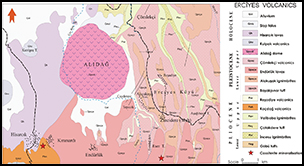Crossref Citations
This article has been cited by the following publications. This list is generated based on data provided by
Crossref.
Erb-Satullo, Nathaniel L.
Gilmour, Brian J.J.
and
Khakhutaishvili, Nana
2015.
Crucible technologies in the Late Bronze–Early Iron Age South Caucasus: copper processing, tin bronze production, and the possibility of local tin ores.
Journal of Archaeological Science,
Vol. 61,
Issue. ,
p.
260.
Wang, Quanyu
Strekopytov, Stanislav
Roberts, Benjamin W.
and
Wilkin, Neil
2016.
Tin ingots from a probable Bronze Age shipwreck off the coast of Salcombe, Devon: Composition and microstructure.
Journal of Archaeological Science,
Vol. 67,
Issue. ,
p.
80.
Serneels, Vincent
2017.
Encyclopedia of Geoarchaeology.
p.
521.
Massa, Michele
and
Palmisano, Alessio
2018.
Change and continuity in the long-distance exchange networks between western/central Anatolia, northern Levant and northern Mesopotamia, c.3200–1600 BCE.
Journal of Anthropological Archaeology,
Vol. 49,
Issue. ,
p.
65.
Kaufman, Brett
2018.
Metallurgical Design and Industry.
p.
1.
Hayakawa, Yuichi S.
Yoshida, Hidetsugu
Obanawa, Hiroyuki
Naruhashi, Ryutaro
Okumura, Koji
Zaiki, Masumi
and
Kontani, Ryoichi
2018.
Characteristics of debris avalanche deposits inferred from source volume estimate and hummock morphology around Mt. Erciyes, central Turkey.
Natural Hazards and Earth System Sciences,
Vol. 18,
Issue. 2,
p.
429.
Ben-Yosef, Erez
2018.
Provenancing Egyptian metals: A methodological comment.
Journal of Archaeological Science,
Vol. 96,
Issue. ,
p.
208.
Erb-Satullo, Nathaniel L.
2019.
The Innovation and Adoption of Iron in the Ancient Near East.
Journal of Archaeological Research,
Vol. 27,
Issue. 4,
p.
557.
YALCİN, Gönül
and
YALÇIN, Ünsal
2019.
Derekutuğun Tarihöncesi Madenci Çıraları.
Süleyman Demirel Üniversitesi Fen-Edebiyat Fakültesi Sosyal Bilimler Dergisi,
Vol. 2,
Issue. 47,
p.
116.
Berger, Daniel
Soles, Jeffrey S.
Giumlia-Mair, Alessandra R.
Brügmann, Gerhard
Galili, Ehud
Lockhoff, Nicole
Pernicka, Ernst
and
Zerboni, Andrea
2019.
Isotope systematics and chemical composition of tin ingots from Mochlos (Crete) and other Late Bronze Age sites in the eastern Mediterranean Sea: An ultimate key to tin provenance?.
PLOS ONE,
Vol. 14,
Issue. 6,
p.
e0218326.
Radivojević, Miljana
Roberts, Benjamin W.
Pernicka, Ernst
Stos-Gale, Zofia
Martinón-Torres, Marcos
Rehren, Thilo
Bray, Peter
Brandherm, Dirk
Ling, Johan
Mei, Jianjun
Vandkilde, Helle
Kristiansen, Kristian
Shennan, Stephen J.
and
Broodbank, Cyprian
2019.
The Provenance, Use, and Circulation of Metals in the European Bronze Age: The State of Debate.
Journal of Archaeological Research,
Vol. 27,
Issue. 2,
p.
131.
Vernet, J.
Ghiara, G.
and
Piccardo, P.
2019.
Are tin oxides inclusions in early archaeological bronzes a marker of metal recycling?.
Journal of Archaeological Science: Reports,
Vol. 24,
Issue. ,
p.
655.
Rodler, A. S.
Klein, S.
Artioli, G.
and
Brøns, C.
2019.
Probing the provenance of archaeological glaze colorants: Polychrome faunal reliefs of the Ishtar Gate and the Processional Way of Babylon.
Archaeometry,
Vol. 61,
Issue. 4,
p.
837.
Mason, Andrea
Powell, Wayne
Bankoff, H. Arthur
Mathur, Ryan
Price, Michael
Bulatović, Aleksandar
and
Filipović, Vojislav
2020.
Provenance of tin in the Late Bronze Age Balkans based on probabilistic and spatial analysis of Sn isotopes.
Journal of Archaeological Science,
Vol. 122,
Issue. ,
p.
105181.
HACAR, Abdullah
and
YENER, K. Aslıhan
2020.
Anatolian Pot Marks in the 3rd Millennium BC: Signage, Early State Formation, and Organization of Production.
Adalya,
p.
25.
Tolksdorf, Johann Friedrich
Schröder, Frank
Petr, Libor
Herbig, Christoph
Kaiser, Knut
Kočár, Petr
Fülling, Alexander
Heinrich, Susann
Hönig, Heide
and
Hemker, Christiane
2020.
Evidence for Bronze Age and Medieval tin placer mining in the Erzgebirge mountains, Saxony (Germany).
Geoarchaeology,
Vol. 35,
Issue. 2,
p.
198.
Hacar, Abdullah
2020.
İlk Tunç Çağı Çanak-Çömlek Üretiminde Uzmanlaşma: Güneybatı Kapadokya’nın Uzmanlaşmış Üretim Örgütlenmesine İlişkin Yorumlar.
Belleten,
Vol. 84,
Issue. 300,
p.
459.
Hauptmann, Andreas
2020.
Archaeometallurgy – Materials Science Aspects.
p.
21.
Powell, Wayne
Johnson, Michael
Pulak, Cemal
Yener, K. Aslihan
Mathur, Ryan
Bankoff, H. Arthur
Godfrey, Linda
Price, Michael
and
Galili, Ehud
2021.
From peaks to ports: Insights into tin provenance, production, and distribution from adapted applications of lead isotopic analysis of the Uluburun tin ingots.
Journal of Archaeological Science,
Vol. 134,
Issue. ,
p.
105455.
Powell, Wayne
Yazgan, Evren
Johnson, Michael
Yener, K. Aslıhan
and
Mathur, Ryan
2021.
Mineralogical Analysis of the Kestel Mine: An Early Bronze Age Source of Tin Ore in the Taurus Mountains, Turkey.
Minerals,
Vol. 11,
Issue. 1,
p.
91.
